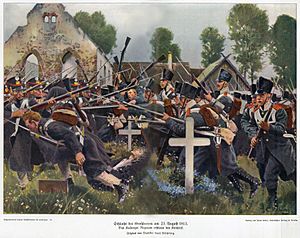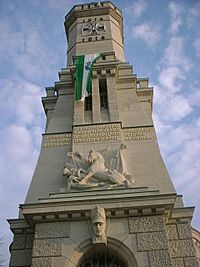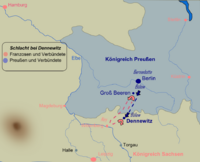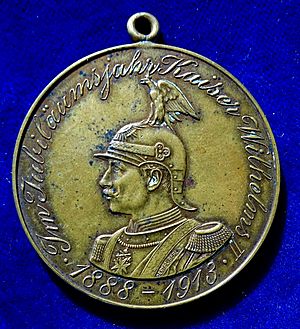Battle of Großbeeren facts for kids
Quick facts for kids Battle of Großbeeren |
|||||||
|---|---|---|---|---|---|---|---|
| Part of the German campaign of the Sixth Coalition | |||||||
 Rain having rendered small arms fire impossible, Saxon infantry (left) use musket butts and bayonets to defend a churchyard against a Prussian onslaught |
|||||||
|
|||||||
| Belligerents | |||||||
| Commanders and leaders | |||||||
|
|
||||||
| Units involved | |||||||
| III Corps | VII Corps | ||||||
| Strength | |||||||
| 32,000 | 18,000 | ||||||
| Casualties and losses | |||||||
| 1,800 6 guns |
3,200 14 guns |
||||||
The Battle of Großbeeren took place on August 23, 1813. It was fought near the towns of Blankenfelde and Sputendorf, south of Berlin. This battle was part of the German campaign during the War of the Sixth Coalition. In this war, several European powers teamed up against Napoleon's French Empire.
The battle involved Prussian forces led by Friedrich von Bülow and a combined French-Saxon army under Jean Reynier. Napoleon wanted to capture Berlin to force Prussia out of the war. However, bad weather, muddy swamps, and the illness of French Marshal Nicolas Oudinot led to a French defeat. The Prussians won this important battle.
Contents
Why the Battle Happened
After a battle in May 1813, both sides agreed to a seven-week break. This break was called a truce. It gave them time to plan and get ready for more fighting. When the war started again in August, Napoleon decided to attack Berlin, the capital of Prussia. He hoped that if Berlin fell, Prussia would leave the war.
Napoleon chose one of his best commanders, Marshal Nicolas Oudinot, to lead this attack. A Marshal is a very high-ranking military officer. Oudinot had been hurt in a previous war in Russia and was not feeling well. He tried to say no, but Napoleon insisted. So, Oudinot marched towards Berlin with about 70,000 soldiers.
The Allies' Plan
What Napoleon didn't know was that his plan fit perfectly into the Allies' strategy. The Allies were the countries fighting against Napoleon. They had a secret plan called the Trachenberg Plan. This plan said they should avoid fighting Napoleon himself in big battles. Instead, they would try to defeat his marshals in smaller battles. This would weaken Napoleon's army before a huge final fight.
At first, the Allied commander, Crown Prince Charles John of Sweden, wasn't sure Berlin could be defended. There weren't many natural barriers south of the city. But the Prussians really wanted to defend their capital. So, Charles John agreed and started preparing Berlin's defenses. He used the local roads and swampy areas to his advantage. He placed his troops to slow down the French on the few roads leading to the city. This would give the rest of his army time to arrive.
Problems for the French
The French attack faced problems from the very beginning. On August 19, heavy rain started. The roads turned into thick mud, making it almost impossible to move heavy artillery (big guns). The area south of Berlin also had many small lakes and swamps. This meant there were only a few roads to approach the city. The rain made things worse, turning many Prussian defense spots into isolated islands.
Marshal Oudinot had to split his army into three separate groups. They had little way to talk to each other.
- To the right, General Bertrand led about 13,000 soldiers and 32 cannons.
- To the left, General Guilleminot had 20,000 soldiers. Many of these were new, inexperienced recruits. They were even nicknamed "Marie-Louises."
- In the middle was the main group, led by General Jean Reynier. This group had 27,000 soldiers, mostly from Saxony, who were allied with France.
Oudinot didn't expect much resistance. He also didn't have enough cavalry (soldiers on horseback) to scout ahead. This meant he didn't know where the enemy was.
The Battle Begins

Berlin was defended by the Army of the North. This army was commanded by Crown Prince Charles John of Sweden. He used to be a French Marshal named Bernadotte.
When Reynier's soldiers reached Großbeeren, they found a large part of Charles John's army ready to fight. Reynier attacked without waiting for orders or help from other French groups. He attacked Friedrich von Bülow's Prussian soldiers. Bülow's group had just been made stronger by Swedish soldiers, reaching 38,000 men.
The Prussians fought back hard. Reynier's attack was pushed back, and his soldiers suffered many losses. Marshal Oudinot arrived later in the day. By then, Reynier's Saxon soldiers were already losing hope and falling back. Oudinot couldn't get his army together to fight effectively.
Von Bülow's Prussian soldiers fought very well and had few losses. They wanted to chase the French right away. But Charles John held them back.
What Happened Next
The Trachenberg Plan in Action
The Trachenberg Plan was the Allies' strategy. It said to avoid fighting Napoleon directly. Instead, they would try to defeat his marshals.
- On August 23, 1813, the Battle of Großbeeren was a Prussian victory. It was against a French army without Napoleon.
- On August 26, 1813, the Battle of the Katzbach was a victory for Russia and Prussia. It was also against a French army without Napoleon.
- On August 26–27, 1813, the Battle of Dresden was a victory for a French army led by Napoleon himself.
The Fight for Berlin Continues
After the defeat, Oudinot realized his army was in a bad spot. He ordered a retreat to Jüterbog. The French suffered heavy losses. Reynier's Saxon soldiers lost many officers and men, plus 14 cannons.
Crown Prince Charles John did not order his army to chase the French. His Prussian generals were very upset. They argued that they could completely destroy the French army if they pursued them. But Charles John was worried. He thought chasing the French might lead them right into Napoleon's trap. He also didn't want to leave his army open to attack from other French forces.
So, the Allied Army of the North stayed in its strong defensive position near Berlin. They waited for another French attack. The defeat at Großbeeren, along with his ongoing illness, made Oudinot lose confidence. He continued retreating.
Napoleon was very angry with Oudinot. Not just for losing, but for retreating to the wrong place. He then put Marshal Michel Ney in charge of a second attack on Berlin. Oudinot became Ney's helper. This new attack would lead to the Battle of Dennewitz on September 6, 1813.
|




